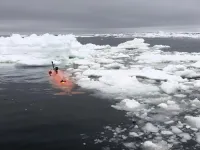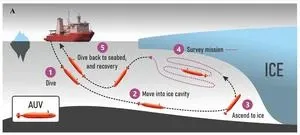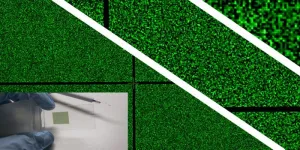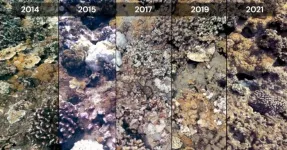(Press-News.org) An international research team deployed the unmanned submarine ‘Ran’ from the University of Gothenburg underneath thick ice in Antarctica. They got back the very first detailed maps of the underside of a glacier, revealing clues to future sea level rise.
The autonomous underwater vehicle, Ran, was programmed to dive into the cavity of Dotson ice shelf in West Antarctica, and scan the ice above it with an advanced sonar system. For 27 days, the submarine travelled a total of over 1.000 kilometres back and forth under the glacier, reaching 17 kilometres into the cavity. An ice shelf is a mass of glacial ice, fed from land by tributary glaciers, that floats in the sea above an ice shelf cavity.
"Like seeing the back of the moon"
“We have previously used satellite data and ice cores to observe how glaciers change over time. By navigating the submersible into the cavity, we were able to get high resolution maps of the ice underside. It's a bit like seeing the back of the moon,” says lead author Anna Wåhlin, Professor of Oceanography at the University of Gothenburg.
In a new scientific paper in Science Advances, the researchers report on the findings of this unique survey. Some things are as expected. The glacier melts faster where strong underwater currents erode its base. Using the submersible, scientists were able to measure the currents below the glacier for the first time and prove why the western part of Dotson Ice Shelf melts so fast. They also see evidence of very high melt at vertical fractures that extend through the glacier.
But the researchers also saw new patterns on the glacier base that raise questions. The surface is not smooth, but there is peak and valley ice scape with plateaus and formations resembling sand dunes. The researchers hypothesize that these may have been formed by flowing water under the influence of Earth's rotation.
Complex areas
Karen Alley, a glaciologist from the University of Manitoba and co-author of this multidisciplinary study, comments on the findings:
“The maps that Ran produced represent a huge progress in our understanding of Antarctica's ice shelves. We've had hints of how complex ice-shelf bases are but Ran uncovered a more extensive and complete picture than ever before. The imagery from the base of Dotson Ice shelf helps us interpret and calibrate what we see from the satellites,” says Karen Alley.
Scientists now realise there is a wealth of processes left to discover in future research missions under the glaciers.
“The mapping has given us a lot of new data that we need to look at more closely. It is clear that many previous assumptions about melting of glacier undersides are falling short. Current models cannot explain the complex patterns we see. But with this method, we have a better chance of finding the answers,” says Anna Wåhlin.
Better models
Dotson Ice Shelf is part of the West Antarctica ice sheet, considered to have a potentially large impact on future sea level rise due to its size and location.
“Better models are needed to predict how fast the ice shelves will melt in the future. It is exciting when oceanographers and glaciologists work together, combining remote sensing with oceanographic field data. This is needed to understand the glaciological changes taking place – the driving force is in the ocean,” says Anna Wåhlin.
A daunting experience
Anna Wåhlin continues: "There are not many uncharted areas left on Earth. To see Ran disappear into the dark, unknown depths below the ice, executing her tasks for over 24 hours without communication, is of course daunting. Experience from over 40 missions below ice gave us confidence but in the end the challenging environment beat us."
The field work for this study was conducted in 2022. In January 2024, the group returned with Ran to Dotson Ice Shelf to repeat the surveys, hoping to document changes.
They were only able to repeat one dive below Dotson ice shelf before Ran disappeared without a trace.
“Although we got valuable data back, we did not get all we had hoped for. These scientific advances were made possible thanks to the unique submersible that Ran was. This research is needed to understand the future of Antarctica’s ice sheet, and we hope to be able to replace Ran and continue this important work,” says Anna Wåhlin.
END
A whole new view on glacier melting in Antarctica
2024-07-31
ELSE PRESS RELEASES FROM THIS DATE:
Study examines suicide contagion following celebrity deaths, opening avenues for prevention
2024-07-31
New research models the rapid and expansive spread of suicidal behaviors following the suicides of Robin Williams in 2014, and of Kate Spade and Anthony Bourdain, which occurred three days apart in 2018.
Columbia University researchers developed a computer model to examine the dynamics underlying suicide contagion. They found that both the 2014 and 2018 events led to large increases in suicidal thought and behavior. The findings, which appear in the journal Science Advances, provide a framework for quantifying suicidal contagion to better understand, prevent, and contain its spread.
“The model we developed ...
Mass extinction 66 million years ago triggered rapid evolution of bird genomes
2024-07-31
ANN ARBOR—Shortly after an asteroid slammed into Earth 66 million years ago, life for non-avian dinosaurs ended, but the evolutionary story for the early ancestors of birds began.
The fossil record tells us that the early ancestors of living birds began their evolutionary journey just after the mass extinction event caused by the asteroid, but researchers weren't sure how they would see that story reflected in bird genomes. Now, a University of Michigan study has identified important changes in birds' genomes sparked by the mass extinction, called the end-Cretaceous mass extinction event, ultimately contributing to ...
The next generation of RNA chips
2024-07-31
An international research team led by the University of Vienna has succeeded in developing a new version of RNA building blocks with higher chemical reactivity and photosensitivity. This can significantly reduce the production time of RNA chips used in biotechnological and medical research. The chemical synthesis of these chips is now twice as fast and seven times more efficient. The results of the research were recently published in the prestigious journal Science Advances.
The emergence and approval of RNA-based medical products, such as mRNA vaccines during the COVID-19 pandemic, has brought the RNA molecule ...
3D models provide unprecedented look at corals’ response to bleaching events
2024-07-31
In a new study, marine biologists from Scripps Institution of Oceanography at UC San Diego and Arizona State University are providing a first-of-its-kind glimpse into coral “bleaching” responses to stress, using imaging technology to pinpoint coral survival rates following multiple bleaching events off the island of Maui. Their findings were published July 31 in the journal PLOS ONE.
Using a time series of coral reef 3D models from Maui, a team of researchers led by Scripps Oceanography’s Smith Lab tracked the bleaching response of 1,832 coral colonies from 2014 to ...
Study finds White Western women have lower body appreciation and greater media pressure to look thin
2024-07-31
White Western women have lower body appreciation and experience greater pressure from the media to be thin compared to Black Nigerian and Chinese women across all ages, according to new research.
The study, carried out by psychologists at Durham University (UK), and published in PLOS ONE, explored the impacts of age and sociocultural pressures on body appreciation (feelings of positivity and pride about one’s body) amongst White Western, Black Nigerian and Chinese women.
Whilst all three groups had relatively stable body appreciation across ages, there were significant cultural differences.
White ...
Underwater mapping reveals new insights into melting of Antarctica's ice shelves
2024-07-31
Clues to future sea level rise have been revealed by the first detailed maps of the underside of a floating ice shelf in Antarctica.
An international research team - including scientists from the University of East Anglia (UEA) - deployed an unmanned submersible beneath the Dotson Ice Shelf in West Antarctica.
The underwater vehicle, ‘Ran’, was programmed to dive into the cavity of the 350metre-thick ice shelf and scan the ice above it with an advanced sonar. Over 27 days, the submarine travelled more than 1000 kilometres back and forth under the shelf, reaching 17 kilometres into the cavity.
An ice shelf is a mass of glacial ice, fed from land by tributary glaciers, that ...
AI creates cardiology reports for patients
2024-07-31
An artificial intelligence program created explanations of heart test results that were in most cases accurate, relevant, and easy to understand by patients, a new study finds.
The study addressed the echocardiogram (echo), which uses sound waves to create pictures of blood flowing through the heart’s chambers and valves. Echo reports include machine-generated numerical measures of function, as well as comments from the interpreting cardiologist on the heart’s size, the pressure in its vessels, and tissue thickness, which can signal the presence of disease. In the form typically generated by doctors, the reports are difficult for ...
Nasal COVID-19 vaccine halts transmission
2024-07-31
The lightning-fast development of COVID-19 vaccines just months after the virus appeared was a triumph of modern science and saved millions of lives. But for all the good they did in reducing illnesses and deaths, the shots were unable to end the pandemic because of one notable weakness: They couldn’t stop the spread of the virus.
A new study by researchers at Washington University School of Medicine in St. Louis indicates that next-generation vaccines that target the virus’s points of entry — the nose and mouth — may be able to do what traditional shots cannot: contain the spread of respiratory infections and prevent transmission. ...
Downwind states face disproportionate burden of air pollution
2024-07-31
A recent Supreme Court decision to block a federal rule curbing interstate air pollution further complicates efforts to reduce emissions and adds to an already disproportionate burden on “downwind” states, according to researchers at the University of Notre Dame.
“Toxic air pollution is really not as well known by the general public as you would hope, given its impact on human health,” said Paola Crippa, assistant professor in the Department of Civil and Environmental Engineering and Earth Sciences. ...
Barriers designed to prevent saltwater intrusion may worsen inland flooding
2024-07-31
As Earth continues to warm, sea levels have risen at an accelerating rate – from 1.4 millimeters a year to 3.6 millimeters a year between 2000 and 2015. Flooding will inevitably worsen, particularly in low-lying coastal regions, where more than a billion people are estimated to live. Solutions are needed to protect homes, property and groundwater from flooding and the intrusion of saltwater.
Seawalls and similar infrastructure are obvious options to protect against flooding. In fact, cities such as New York and San Franciso have already thrashed out potential plans with the Army Corps of Engineers that will heavily rely ...






